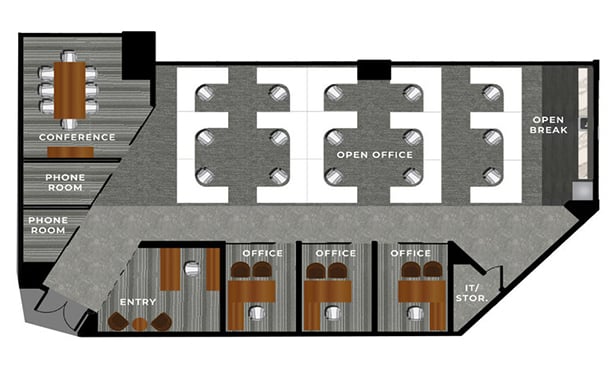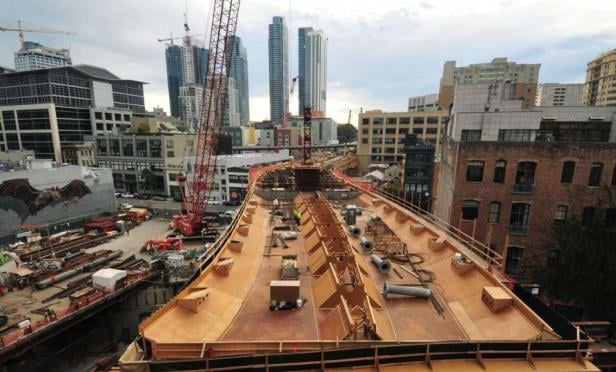DALLAS—In the blink of an eye, storm damage can cause major property issues, not to mention major expenses. Roofs, unfortunately, take most of the force during hail, harsh winds and heavy downpours.
Understanding how to accurately assess damage is a crucial step when performing repairs. If the right steps are not taken, it could create future long-term issues. Eric Skoog, president of SUNVEK Roofing, recently discussed the issues surrounding storm assessment and damage in this exclusive.
GlobeSt.com: What should property managers/building owners look for after a big storm such as tornadoes with high winds?
Skoog: The extent of roof damage can be affected by the type of roofing installed. How to properly assess damage varies depending on the style of roof. For instance, walking around a building perimeter and looking up at a shingle roof may reveal missing or folded shingles. Physically walking the roof is beneficial to identify typical evidence of hail damage, where granule loss in indentations or crossing key-ways (slits in the shingles for appearance) shows evidence of hail impact. For metal roofs, it is important to physically walk the roofs to identify evidence of hail damage and/or loose panels.
GlobeSt.com: What is the likely damage to a roof after a harsh wind storm or tornado?
Skoog: Modern shingle styles (known as architectural or dimensional shingles) are designed to handle wind speeds of up to 110 mph without ripping apart. However, they can still be folded over by wind, shaken violently in gusty winds resulting in loss of granules, and even ripped out by strong winds and/or lack of proper installation techniques.
Metal roofs are becoming more popular. They can fade over time, steel can rust, aluminum oxidizes and both copper and zinc will patina. More common damage to metal roofs is caused by hail (denting) and wind (ripping panels loose or otherwise damaging them).
As for tile roofs, tile is damaged by objects, wind lifting and shifting the tile, and excessive movement along the roof surface. Broken, wind-blown and dangling tiles are indications of problems.
GlobeSt.com: What can property managers/building owners do to prevent long-term damage to their buildings' roofs?
Skoog: Implementing a routine maintenance plan is beneficial to any roof system to prevent long-term damage. Having a competent roofing representative walk roofs periodically and assess the condition can be an invaluable means of effectively managing roof costs. In the event there is evidence of damage, especially where water has entered, temporarily covering the damaged area of the roof with a tarp extending from the high point of the roof down below the area where water entered and then at least 5 feet to either side, will help minimize further damage. Minor issues noted may be addressed immediately, and more significant measures may be scheduled in the budget so cash planning can be more effectively managed. Unfortunately, even the most proactive maintenance schedule cannot prevent damage from major storms and high winds. It may, however, help to minimize the extent of damage and make subsequent repairs easier.
GlobeSt.com: What proactive steps can property managers/building owners take before a tornado hits to ensure the safety of buildings?
Skoog: With high winds, some damage is inevitable and there is nothing you can do to prevent damage. However, there are ways to protect buildings to the best of your ability. Planning ahead by trimming any trees and shrubbery that could cause potential damage, getting your annual roof check, quickly repairing any existing damage, considering a roof upgrade to a stronger material that can withstand harsh wind and hail, etc., will all help the stability of your property.
GlobeSt.com: What should property managers/building owners look for in a roofing expert?
Skoog: Avoid storm chasers who are looking for an easy scam, ask about licensing to verify their duration in business, choose someone local, seek referrals, etc.
DALLAS—In the blink of an eye, storm damage can cause major property issues, not to mention major expenses. Roofs, unfortunately, take most of the force during hail, harsh winds and heavy downpours.
Understanding how to accurately assess damage is a crucial step when performing repairs. If the right steps are not taken, it could create future long-term issues. Eric Skoog, president of SUNVEK Roofing, recently discussed the issues surrounding storm assessment and damage in this exclusive.
GlobeSt.com: What should property managers/building owners look for after a big storm such as tornadoes with high winds?
Skoog: The extent of roof damage can be affected by the type of roofing installed. How to properly assess damage varies depending on the style of roof. For instance, walking around a building perimeter and looking up at a shingle roof may reveal missing or folded shingles. Physically walking the roof is beneficial to identify typical evidence of hail damage, where granule loss in indentations or crossing key-ways (slits in the shingles for appearance) shows evidence of hail impact. For metal roofs, it is important to physically walk the roofs to identify evidence of hail damage and/or loose panels.
GlobeSt.com: What is the likely damage to a roof after a harsh wind storm or tornado?
Skoog: Modern shingle styles (known as architectural or dimensional shingles) are designed to handle wind speeds of up to 110 mph without ripping apart. However, they can still be folded over by wind, shaken violently in gusty winds resulting in loss of granules, and even ripped out by strong winds and/or lack of proper installation techniques.
Metal roofs are becoming more popular. They can fade over time, steel can rust, aluminum oxidizes and both copper and zinc will patina. More common damage to metal roofs is caused by hail (denting) and wind (ripping panels loose or otherwise damaging them).
As for tile roofs, tile is damaged by objects, wind lifting and shifting the tile, and excessive movement along the roof surface. Broken, wind-blown and dangling tiles are indications of problems.
GlobeSt.com: What can property managers/building owners do to prevent long-term damage to their buildings' roofs?
Skoog: Implementing a routine maintenance plan is beneficial to any roof system to prevent long-term damage. Having a competent roofing representative walk roofs periodically and assess the condition can be an invaluable means of effectively managing roof costs. In the event there is evidence of damage, especially where water has entered, temporarily covering the damaged area of the roof with a tarp extending from the high point of the roof down below the area where water entered and then at least 5 feet to either side, will help minimize further damage. Minor issues noted may be addressed immediately, and more significant measures may be scheduled in the budget so cash planning can be more effectively managed. Unfortunately, even the most proactive maintenance schedule cannot prevent damage from major storms and high winds. It may, however, help to minimize the extent of damage and make subsequent repairs easier.
GlobeSt.com: What proactive steps can property managers/building owners take before a tornado hits to ensure the safety of buildings?
Skoog: With high winds, some damage is inevitable and there is nothing you can do to prevent damage. However, there are ways to protect buildings to the best of your ability. Planning ahead by trimming any trees and shrubbery that could cause potential damage, getting your annual roof check, quickly repairing any existing damage, considering a roof upgrade to a stronger material that can withstand harsh wind and hail, etc., will all help the stability of your property.
GlobeSt.com: What should property managers/building owners look for in a roofing expert?
Skoog: Avoid storm chasers who are looking for an easy scam, ask about licensing to verify their duration in business, choose someone local, seek referrals, etc.
Want to continue reading?
Become a Free ALM Digital Reader.
Once you are an ALM Digital Member, you’ll receive:
- Breaking commercial real estate news and analysis, on-site and via our newsletters and custom alerts
- Educational webcasts, white papers, and ebooks from industry thought leaders
- Critical coverage of the property casualty insurance and financial advisory markets on our other ALM sites, PropertyCasualty360 and ThinkAdvisor
Already have an account? Sign In Now
*May exclude premium content© 2024 ALM Global, LLC, All Rights Reserved. Request academic re-use from www.copyright.com. All other uses, submit a request to [email protected]. For more information visit Asset & Logo Licensing.









